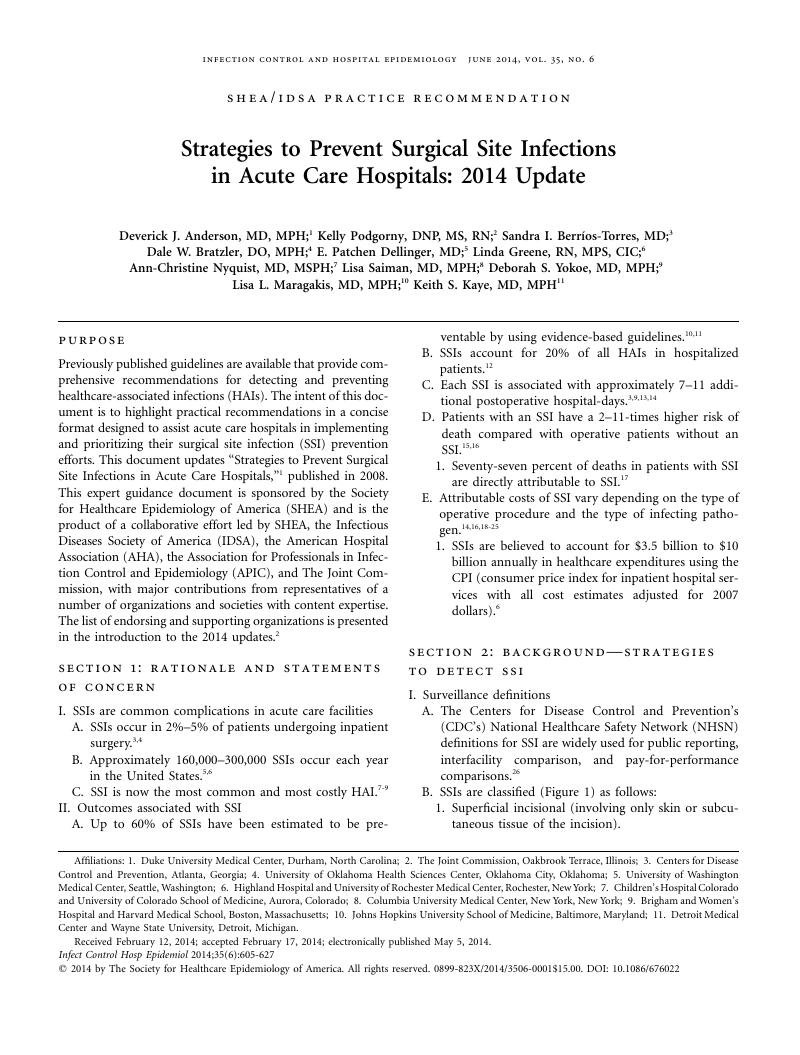Crossref Citations
This article has been cited by the following publications. This list is generated based on data provided by Crossref.
Otter, J.A.
2014.
Journal Roundup.
Journal of Hospital Infection,
Vol. 87,
Issue. 4,
p.
249.
Benito, Natividad
Pericas, Juan M.
Gurguí, Mercè
Mestres, Carlos A.
Marco, Francesc
Moreno, Asunción
Horcajada, Juan P.
and
Miró, José M.
2014.
Health Care-Associated Infective Endocarditis: a Growing Entity that Can Be Prevented.
Current Infectious Disease Reports,
Vol. 16,
Issue. 11,
Yokoe, Deborah S.
Anderson, Deverick J.
Berenholtz, Sean M.
Calfee, David P.
Dubberke, Erik R.
Ellingson, Katherine D.
Gerding, Dale N.
Haas, Janet P.
Kaye, Keith S.
Klompas, Michael
Lo, Evelyn
Marschall, Jonas
Mermel, Leonard A.
Nicolle, Lindsay E.
Salgado, Cassandra D.
Bryant, Kristina
Classen, David
Crist, Katrina
Deloney, Valerie M.
Fishman, Neil O.
Foster, Nancy
Goldmann, Donald A.
Humphreys, Eve
Jernigan, John A.
Padberg, Jennifer
Perl, Trish M.
Podgorny, Kelly
Septimus, Edward J.
VanAmringe, Margaret
Weaver, Tom
Weinstein, Robert A.
Wise, Robert
and
Maragakis, Lisa L.
2014.
A Compendium of Strategies to Prevent Healthcare-Associated Infections in Acute Care Hospitals: 2014 Updates.
Infection Control & Hospital Epidemiology,
Vol. 35,
Issue. 8,
p.
967.
Mitsuda, Toshihiro
2014.
3. Prevent Health Care-Associated Infections (HAIs): Up-to-date Information.
Nihon Naika Gakkai Zasshi,
Vol. 103,
Issue. 11,
p.
2748.
Calfee, David P.
Salgado, Cassandra D.
Milstone, Aaron M.
Harris, Anthony D.
Kuhar, David T.
Moody, Julia
Aureden, Kathy
Huang, Susan S.
Maragakis, Lisa L.
and
Yokoe, Deborah S.
2014.
Strategies to Prevent Methicillin-ResistantStaphylococcus aureusTransmission and Infection in Acute Care Hospitals: 2014 Update.
Infection Control & Hospital Epidemiology,
Vol. 35,
Issue. S2,
p.
S108.
Yokoe, Deborah S.
Anderson, Deverick J.
Berenholtz, Sean M.
Calfee, David P.
Dubberke, Erik R.
Eilingson, Katherine D.
Gerding, Dale N.
Haas, Janet P.
Kaye, Keith S.
Klompas, Michael
Lo, Evelyn
Marschall, Jonas
Mermel, Leonard A.
Nicolle, Lindsay E.
Salgado, Cassandra D.
Bryant, Kristina
Classen, David
Crist, Katrina
Deloney, Valerie M.
Fishman, Neil O.
Foster, Nancy
Goldmann, Donald A.
Humphreys, Eve
Jernigan, John A.
Padberg, Jennifer
Perl, Trish M.
Podgorny, Kelly
Septimus, Edward J.
VanAmringe, Margaret
Weaver, Tom
Weinstein, Robert A.
Wise, Robert
and
Maragakis, Lisa L.
2014.
A Compendium of Strategies to Prevent Healthcare-Associated Infections in Acute Care Hospitals: 2014 Updates.
Infection Control & Hospital Epidemiology,
Vol. 35,
Issue. S2,
p.
S21.
Calfee, David P.
Salgado, Cassandra D.
Milstone, Aaron M.
Harris, Anthony D.
Kuhar, David T.
Moody, Julia
Aureden, Kathy
Huang, Susan S.
Maragakis, Lisa L.
and
Yokoe, Deborah S.
2014.
Strategies to Prevent Methicillin-ResistantStaphylococcus aureusTransmission and Infection in Acute Care Hospitals: 2014 Update.
Infection Control & Hospital Epidemiology,
Vol. 35,
Issue. 7,
p.
772.
Calderwood, Michael S.
Kleinman, Ken
Murphy, Michael V.
Platt, Richard
and
Huang, Susan S.
2014.
Improving Public Reporting and Data Validation for Complex Surgical Site Infections After Coronary Artery Bypass Graft Surgery and Hip Arthroplasty.
Open Forum Infectious Diseases,
Vol. 1,
Issue. 3,
Scheinerman, S. Jacob
Dlugacz, Yosef D.
Hartman, Alan R.
Moravick, Donna
Nelson, Karen L.
Scanlon, Kerri Anne
and
Stier, Lori
2015.
Journey to Top Performance: A Multipronged Quality Improvement Approach to Reducing Cardiac Surgery Mortality.
The Joint Commission Journal on Quality and Patient Safety,
Vol. 41,
Issue. 2,
p.
52.
Sciortino, Carmen V.
Kemper, Mary
Parthasarathy, Latha
and
Lay, James
2015.
Surveillance of Methicillin-Resistant Staphylococcus aureus Mupirocin Resistance in a Veterans Affairs Hospital.
Infection Control & Hospital Epidemiology,
Vol. 36,
Issue. 2,
p.
235.
John, Jisha
Miletic, Kyle
and
Kaye, Keith S.
2015.
Skin and Skin Structure Infections in Older Adults.
Current Geriatrics Reports,
Vol. 4,
Issue. 1,
p.
70.
Weinshel, Kristy
Dramowski, Angela
Hajdu, Ágnes
Jacob, Saul
Khanal, Basudha
Zoltán, Maszárovics
Mougkou, Katerina
Phukan, Chimanjita
Inés Staneloni, Maria
and
Singh, Nalini
2015.
Gap Analysis of Infection Control Practices in Low- and Middle-Income Countries.
Infection Control & Hospital Epidemiology,
Vol. 36,
Issue. 10,
p.
1208.
Reese, Sara M.
Knepper, Bryan C.
Price, Connie S.
and
Young, Heather L.
2015.
An Evaluation of Surgical Site Infection Surveillance Methods for Colon Surgery and Hysterectomy in Colorado Hospitals.
Infection Control & Hospital Epidemiology,
Vol. 36,
Issue. 3,
p.
353.
Vilas-Boas, Vanessa Aparecida
Mingotte, Paula
and
Freitas, Maria Isabel Pedreira de
2015.
Vigilância pós-alta por telefone: validação e aplicação de instrumento para cirurgias vídeo-assistidas.
Revista Brasileira de Enfermagem,
Vol. 68,
Issue. 5,
p.
899.
Miller, Julie
Hayes, Denise Drummond
and
Carey, Katherine W.
2015.
20 questions.
Nursing,
Vol. 45,
Issue. 8,
p.
46.
Balsa, Ingrid M.
and
Culp, William T.N.
2015.
Wound Care.
Veterinary Clinics of North America: Small Animal Practice,
Vol. 45,
Issue. 5,
p.
1049.
Durkin, Michael J.
Dicks, Kristen V.
Baker, Arthur W.
Lewis, Sarah S.
Moehring, Rebekah W.
Chen, Luke F.
Sexton, Daniel J.
and
Anderson, Deverick J.
2015.
Seasonal Variation of Common Surgical Site Infections: Does Season Matter?.
Infection Control & Hospital Epidemiology,
Vol. 36,
Issue. 9,
p.
1011.
Brown, Jennifer
Li, Chin-Shang
Giordani, Mauro
Shahlaie, Kiarash
Klineberg, Eric O.
Tripet-Diel, Joanna R.
Ihara, Marie S.
and
Cohen, Stuart H.
2015.
Swabbing Surgical Sites Does Not Improve the Detection of Staphylococcus aureus Carriage in High-Risk Surgical Patients.
Surgical Infections,
Vol. 16,
Issue. 5,
p.
523.
Apisarnthanarak, Anucha
Singh, Nalini
Bandong, Aila Nica
and
Madriaga, Gilbert
2015.
Triclosan-Coated Sutures Reduce the Risk of Surgical Site Infections: A Systematic Review and Meta-analysis.
Infection Control & Hospital Epidemiology,
Vol. 36,
Issue. 2,
p.
169.
von Eiff, Wilfried
2015.
International Best Practices in Health Care Management.
Vol. 17,
Issue. ,
p.
223.



